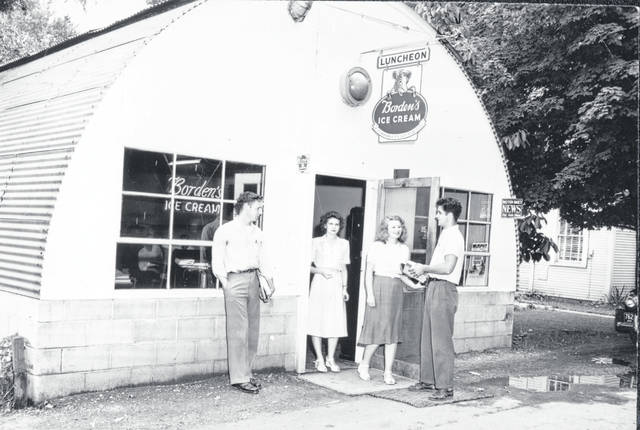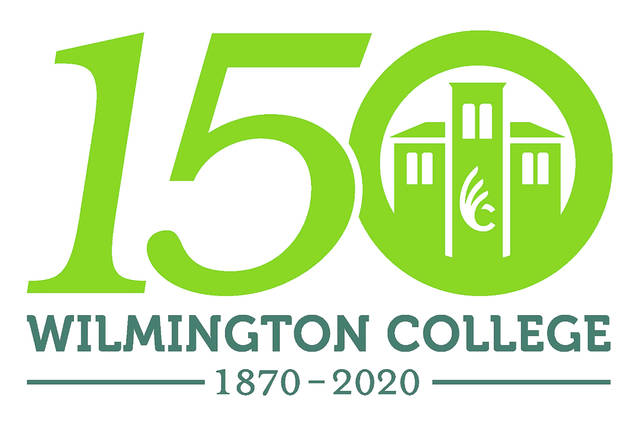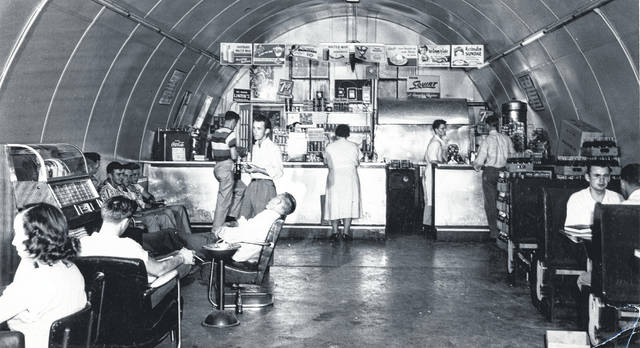


Editor’s Note: In observance of Wilmington College’s sesquicentennial anniversary this year, stories hearkening the institution’s 150 years will appear periodically in the News Journal throughout 2020.
WILMINGTON — A jukebox, pinball machine, shakes and malts, burgers and fries, Hires Root Beer and Borden’s Ice Cream.
Sounds like an idyllic scene out of TV’s “Happy Days.” But it was real life on Wilmington College’s campus in the form of a snack bar known as The Cove.
During the immediate post-World War II years, an Army surplus Quonset hut occupied the site of what is now Friends Hall off Quaker Way.
Prior to its removal in 1997, the prefabricated structure, which featured semi-circular roof of corrugated metal that curved down to form walls, served a diverse range of purposes. But its first and greatest manifestation was as a student union in the late 1940s and early ‘50s.
Some 20 years ago, Herman Fisher, Class of ’51, reminisced about The Cove.
“It was the student union in those days,” said Fisher, who served as The Cove’s student manager in 1950 and ‘51. He recalled the College provided the building and utilities; however, students had to run it at a profit to keep it going. Indeed, it was an operation with few frills.
“We didn’t even write up menus,” Fisher said. “People were yelling, ‘I need a cheeseburger with ketchup; hold the pickles!’”
“When you walked in the door, there were booths on the right, a juke box on the left, the counter and grill, and a cigarette machine – there was no smoking on campus before the GIs came back, but things changed in the late ‘40s,” he said.
Indeed, WC welcomed an influx of World War II veterans in the advent of the GI Bill, a measure that literally changed the face of the College and boosted enrollment to historic levels. That made campus amenities like The Cove all the more important to College life.
“You could get ice cream, soft drinks, malts, shakes and some food,” reminisced Muriel Specht Hiatt, dean of women from 1948-52 and part-time assistant dean of students during the 1960s. “The Cove was surprisingly adequate for the time.”
Glenn Phillips ’49 recalled the Quonset that became The Cove and another Army surplus hut both arriving in late 1947.
“We’d go there for Cokes or coffee and sit in there and talk,” he said. “It was a popular gathering place.”
Hiatt said it was a “good, informal place” for faculty and staff as well. “That was there President Marble got to know many students,” she added.
Sam Marble arrived as Wilmington’s new president in fall of 1947. The influx of GIs on campus quickly quadrupled student enrollment from the War years’ levels, causing a severe shortage of campus buildings, particularly student housing.
In addition to the Army surplus Quonsets, the College secured three Army barracks, which housed male students on the present site of Boyd Cultural Arts Center, and some house trailers for married students that were located in the area of Pyle Student Center.
Fisher, who earned $60 a week managing The Cove, recalled marathon euchre games, nickel candy bars and bottles of Coke and Pepsi for five cents. He had to walk the fine line between not charging enough to make a profit and charging more than the student market was willing to pay. His solution was to diversify.
“Our costs were going up and I was going to have to go up to 20 cents for a hamburger,” he said, noting he also was in need of temperature control devices for The Cove, which, “like the Quonsets I stayed in during my military service,” was either too hot or too cold.
He also made a deal with the man who supplied 45 rpm records for the jukebox — they split those profits 50/50. However, that wasn’t nearly enough to cover The Cove’s ever-increasing expenses.
“He said, if we put a pinball machine in, The Cove would make more money,” Fisher said, noting he immediately proposed the issue with the president. “Sam said we could try one, but, if there was any gambling, it would be taken out.”
Pinball was a big hit and provided needed funds for a pedestal fan and gas heater. Later a second machine was added.
Robert S. Bravard ’57 recalled The Cove housing the only pop machine around where one could buy a bottle of Dr. Pepper, then a rare commodity in Ohio. “I had learned to drink it from my North Carolina relatives and was pleased to find it in a machine on campus,” he said.
When Friends Hall was completed in 1955, The Cove closed its doors and the Quonset that housed the student union was moved next to the other Quonset hut near the Industrial Education (IE) Building on Douglas Street.
Between the closing of the popular student hangout and the opening of Pyle Center for Students in 1957, a temporary student union was housed in the old music building, which was located in a house across the alley south of Bailey Hall.
The College used the Quonset huts for IE storage until the Industrial Arts Center (now Robinson Communication Center) was built in 1974. In more recent years, the huts were used to house theater props, sets and costumes, as well as maintenance equipment and contractors’ supplies.
In the summer of 1997, the Quonsets were disassembled with most of the parts taken to the College’s academic farms; however, some of the corrugated metal was diverted to the home of an old friend. Indeed, Fisher used part of the shell as a cover for firewood.
“I guess it still has some sentimental value for me,” he said in 2000. “That era was a neat time to be at the College and working at The Cove helped us out a lot!”




